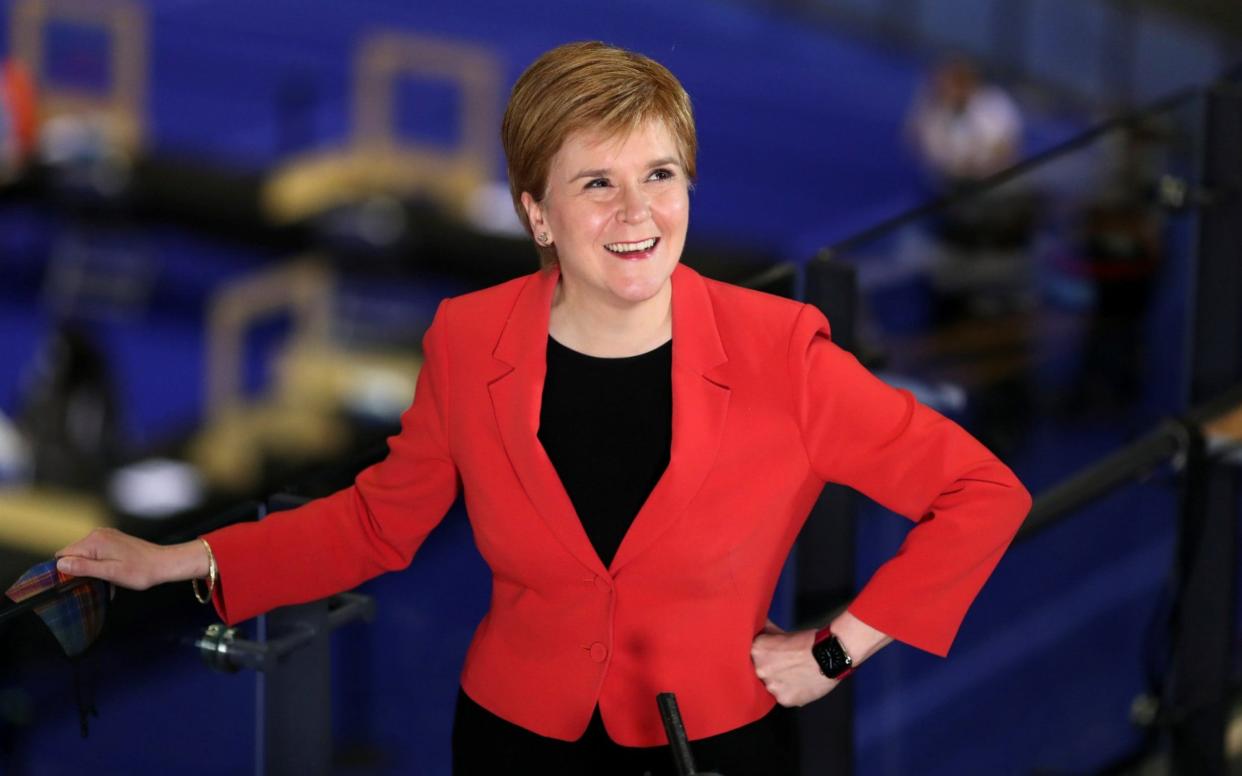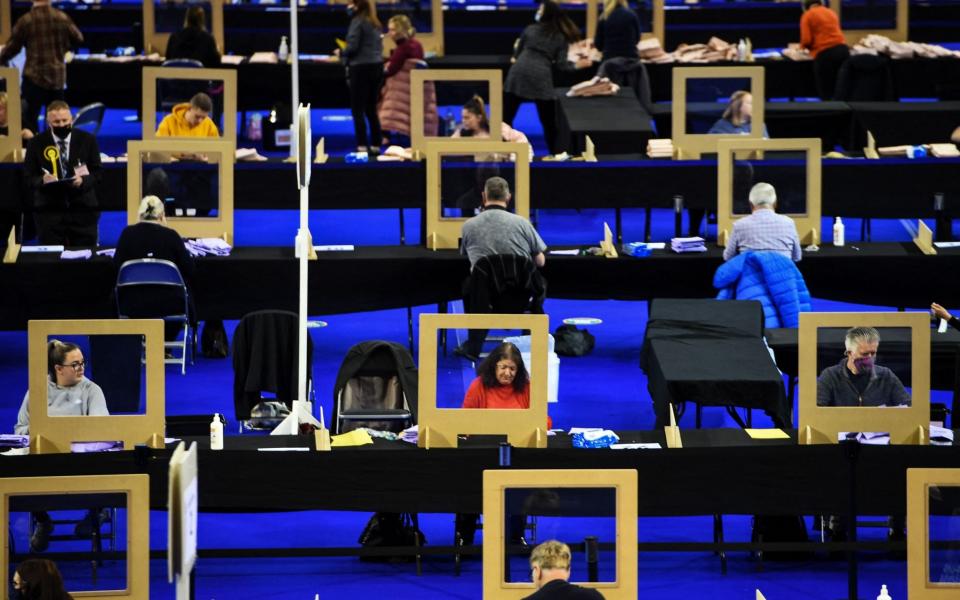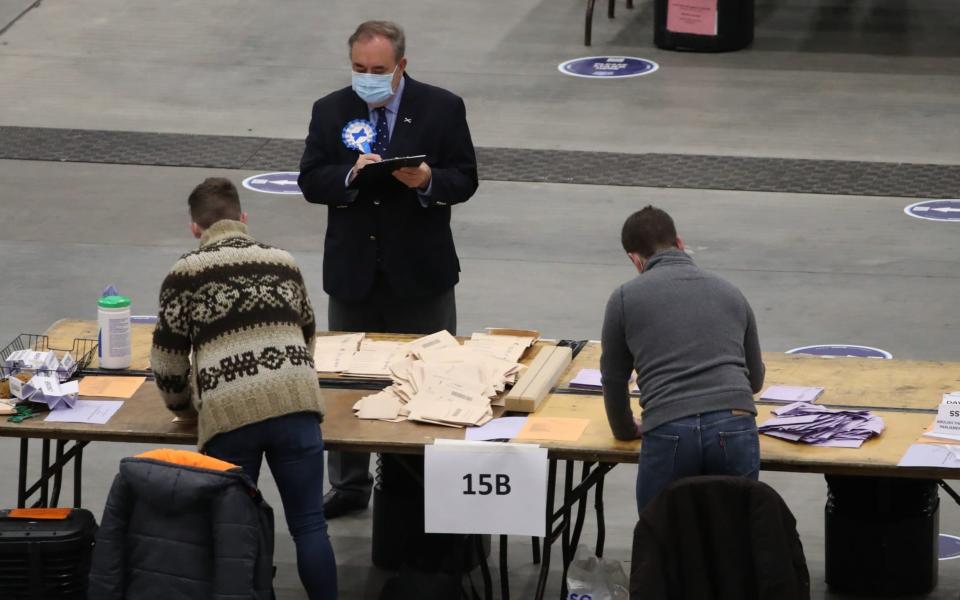Nicola Sturgeon set for clear win but ‘unlikely’ to get SNP majority

- Oops!Something went wrong.Please try again later.
- Oops!Something went wrong.Please try again later.
Nicola Sturgeon was on Friday night heading for a clear Holyrood election win – but may miss out on the SNP majority that would place huge pressure on Boris Johnson to drop his opposition to a second independence referendum.
The Scottish Tories lost to the SNP two of the seven constituencies they won in the 2016 election following a huge surge in turnout from nationalist voters. With nationalists also gaining East Lothian from Labour and holding all their 2016 seats, they were edging towards the 65 seats needed for a majority.
But widespread Unionist tactical voting saw the SNP fall short in other key target seats, with Jackson Carlaw, the former Scottish Tory leader, holding Eastwood.
Labour's Jackie Baillie then held what was Scotland's most marginal seat, increasing her majority in Dumbarton from 109 to 1,483.
Prof John Curtice, Britain's most eminent pollster, said Ms Baillie's "successful defence of her Dumbarton constituency means it is now unlikely that the SNP will achieve an overall majority in the new Holyrood parliament".
He added: "I think the most probable outcome is going to be that the SNP is going to be one or two seats short, and we are therefore looking at an SNP-Green majority for a referendum, rather than the SNP on their own.
"Two things might flow from that: first, the UK Government will feel more emboldened to say no to the request that is bound to happen at some point from the new parliament."
However, he said Ms Sturgeon being in a "weaker position" in resisting her party members demands for another vote may mean she makes an earlier push for a referendum.
The SNP won 39 of the 48 constituencies announced on Friday, giving the Nationalists a fourth term and an overwhelming win 14 years after they took office.
Covid safety restrictions on the counting of ballot papers mean the remaining 25 constituencies and the 56 regional list MSPs will not be declared until Saturday afternoon or evening.

Any hope of an SNP majority hangs on results being announced on Saturday in a handful of Tory seats including Aberdeenshire West and Galloway and West Dumfries.
The Conservatives were also hoping that an increase in support on the regional list, which allocates seats to parties using a complicated form of proportional representation, would deliver enough seats for them to stop Ms Sturgeon. They were confident of finishing in a clear second place ahead of Labour, which was on course to lose seats despite the popularity of new leader Anas Sarwar.
An SNP majority would be a nightmare for Mr Johnson, making it much more difficult to refuse Ms Sturgeon’s request for a referendum than if she had fallen short.
The results were in stark contrast to the huge success the Prime Minister enjoyed in the English local elections and the Hartlepool by-election, with the seat turning blue for the first time ever, punching another hold in the so-called Red Wall.
Mr Johnson told The Telegraph that his impression was that Scottish voters had “moved away from the idea of a referendum”.
He said: “I don’t think this is anything like the time to have more constitutional wrangling, to be talking about ripping our country apart, when actually people want to heal our economy and bounce forward together. That’s what people want.”
Ms Sturgeon initially tried to downplay the prospect of an SNP majority when she arrived at the count for her Glasgow Southside seat, which she won by 9,456 votes.
But in her victory speech, she said: “If that is indeed the outcome of this election, I pledge today to get back to work immediately to continue to steer the country through the crisis of Covid, to continue to lead this country into recovery from Covid.”
Referring to a second referendum, she added: “And then, when the time is right, to offer this country the choice of a better future.”
She denied that falling short of a majority would weaken her case for a separation vote, arguing that there would still be a significant mandate if the SNP and pro-separation Greens together met this benchmark. This is all but guaranteed.
However, Jeremy Balfour, a Scottish Tory candidate, predicted that the number of voters backing Unionist parties would exceed the total backing the SNP when the final result is known on Saturday.
Ms Sturgeon has pledged she will focus on tackling Covid initially, but plans a second referendum by the end of 2023, when Scotland is still recovering from the pandemic.
If the Prime Minister refuses to hand her the necessary powers, she intends to press ahead with her own vote and challenge him to block it in the courts.
Although the Tory vote held up in their constituencies and target seats, support for the SNP increased by an even larger amount in some key seats following a stunningly successful get-out-the-vote operation. Turnout was around 10 points higher in many constituencies compared to 2016.
In an example of the SNP surge, Murdo Fraser, the Tory candidate, managed to increase his vote by more than 2,500 on the 2016 result in Perthshire North. But John Swinney, the Deputy First Minister, increased his majority by adding more than 3,300 votes to his 2016 tally. Turnout was 70 per cent – 7.3 points higher than in the last election.
The Conservatives also believed that too few Liberal Democrat and Labour supporters had been willing to vote tactically for them to stop the Nationalists. Tory John Scott lost his Ayr seat to the SNP by only 170 votes.
Angus Robertson, the SNP’s former Westminster leader, then took Ruth Davidson’s former seat of Edinburgh Central by 4,732 votes.

In contrast, Tory supporters voted tactically in large numbers for Labour and Liberal Democrat candidates in other seats where those two parties were the closest challengers to the SNP.
Conservative tactical voting is believed to have helped Liberal Democrat Alex Cole-Hamilton massively increase his majority to 10,000 in Edinburgh Western, which was a key SNP target seat.
Similarly, Tory tactical votes helped Labour’s Daniel Johnson hold Edinburgh Southern, another key marginal.
Douglas Ross, the Scottish Tory leader, said there had been a “mixed picture” across Scotland, with surges in Tory support in some areas but disappointing results in others.
Willie Rennie, the Scottish Liberal Democrat leader, doubled his majority as he held his North East Fife seat. He said: “I hope all the candidates in this election hear the message from the voters that now is not the moment for another referendum. We need to listen to that.”

Asked on BBC Scotland if his Alba Party would win seats when the regional list seats were allocated on Saturday, Alex Salmond, the former first minister, said: “I don’t think so, on the results we’ve seen”.

